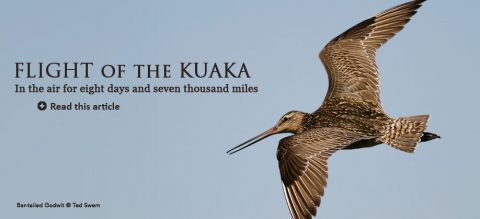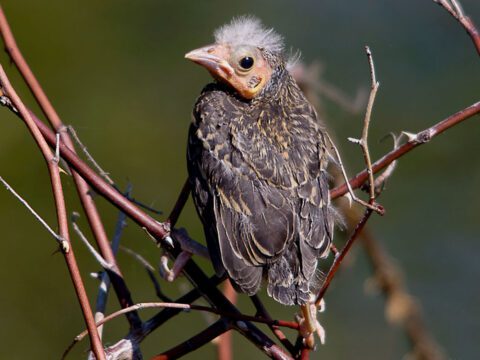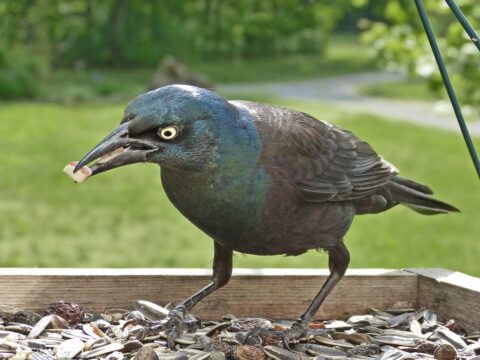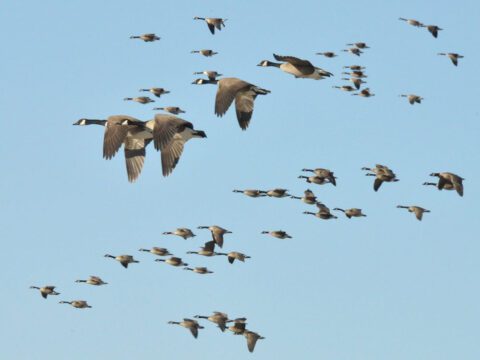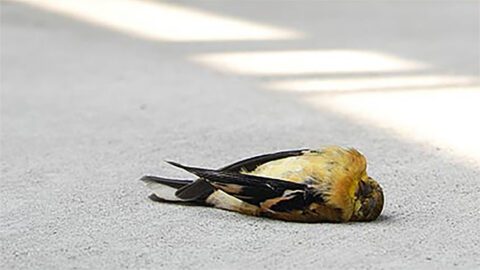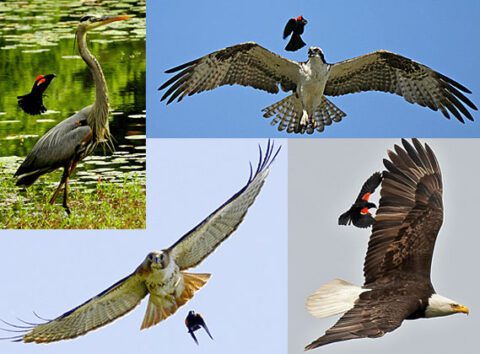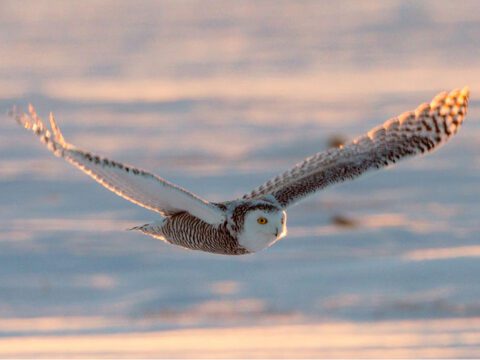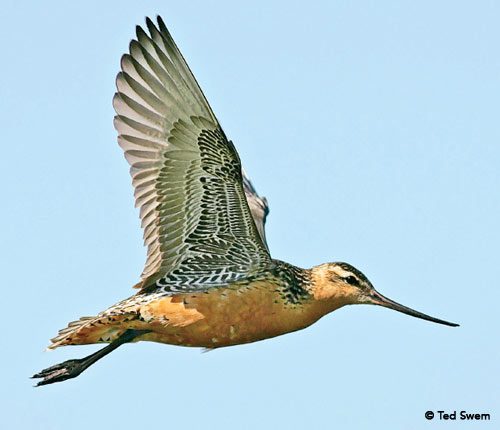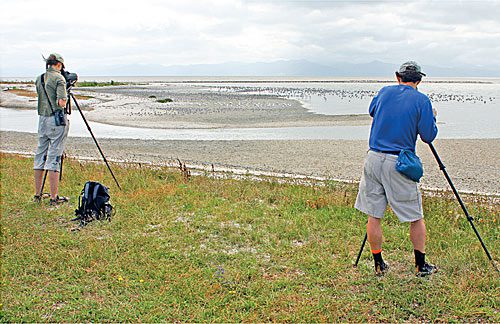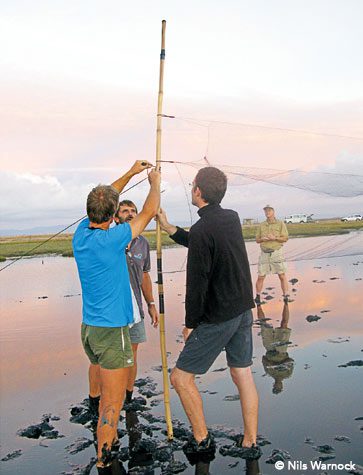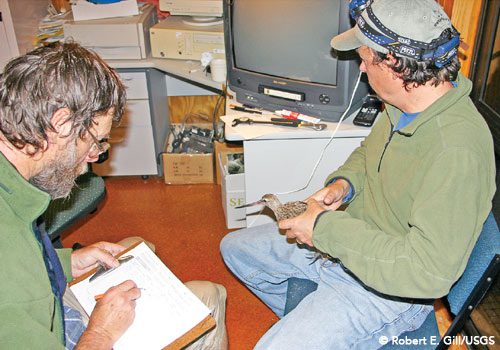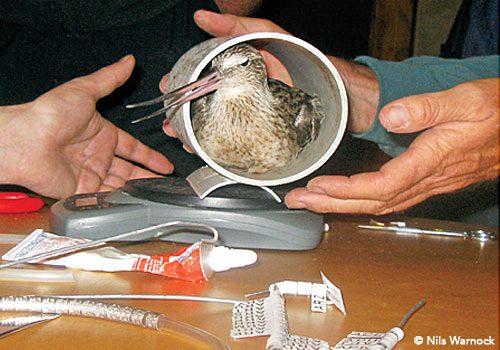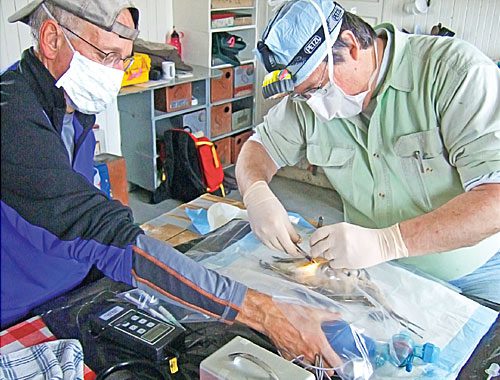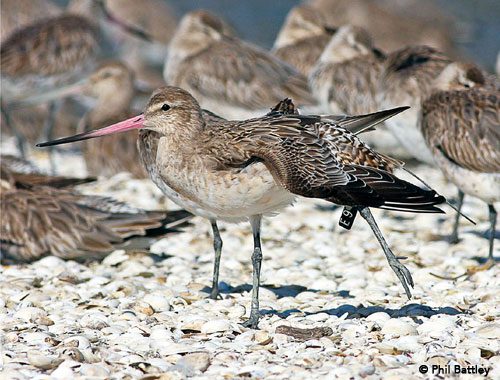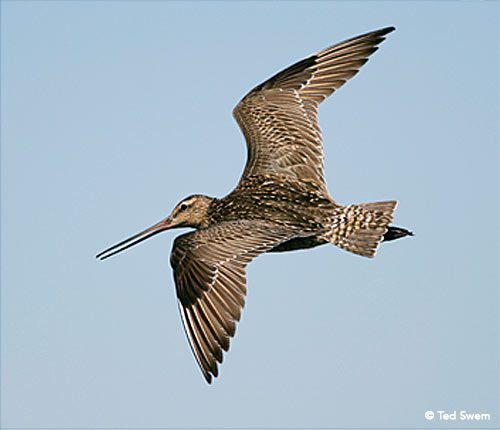Flight of the Kuaka: A Godwit Makes the Longest Nonstop Flight Ever Recorded
by Don Stap
October 15, 2009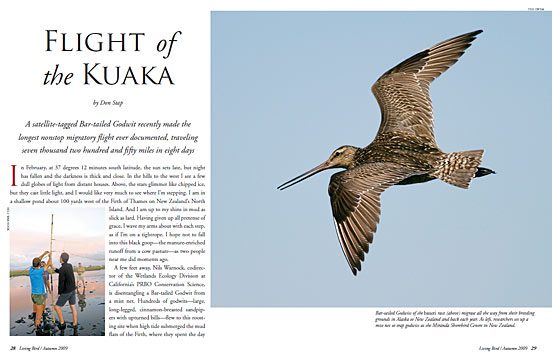
In February, at 37 degrees 12 minutes south latitude, the sun sets late, but night has fallen and the darkness is thick and close. In the hills to the west I see a few dull globes of light from distant houses. Above, the stars glimmer like chipped ice, but they cast little light, and I would like very much to see where I’m stepping. I am in a shallow pond about 100 yards west of the Firth of Thames on New Zealand’s North Island. And I am up to my shins in mud as slick as lard. Having given up all pretense of grace, I wave my arms about with each step, as if I’m on a tightrope. I hope not to fall into this black goop—the manure-enriched runoff from a cow pasture—as two people near me did moments ago.
A few feet away, Nils Warnock, codirector of the Wetlands Ecology Division at California’s PRBO Conservation Science, is disentangling a Bar-tailed Godwit from a mist net. Hundreds of godwits—large, long-legged, cinnamon-breasted sandpipers with upturned bills—flew to this roosting site when high tide submerged the mud flats of the Firth, where they spent the day feeding and preening. Warnock, who speaks softly and slowly, never seems to be in a hurry, but suddenly he is moving quickly in my direction. He’s holding three godwits, taking them to a site on dry ground where the birds are being separated into holding crates according to sex. But apparently he has taken one too many birds. “Here,” he says, handing me a warm bundle with long, kicking legs. “Don’t hold him too tightly.” I cradle the bird against my body and stumble through the darkness, the godwit’s heart beating like a trapped moth against my chest.
New Zealand is the principal wintering site for the baueri race of the Bar-tailed Godwit, a subspecies that breeds in Alaska. The bird’s annual journey to these southern latitudes caught the attention of South Sea islanders long ago. About 950 A.D. a group of Polynesians left their homeland, heading out across the South Pacific in seagoing canoes for a land they believed existed somewhere to the south. Their only guide was the flight path of an elegant bird they knew as thekuaka—the Bar-tailed Godwit—which they had observed flying south each year at the same time. Because the kuaka was not a seabird, they reasoned it must go to some land as yet undiscovered.
They were right. The explorers eventually saw a cloud on the horizon that stretched for miles, hanging, they correctly guessed, above a large land mass. So goes a Maori legend describing how their ancestors discovered New Zealand. They were the first humans to set foot on the island they called Aotearoa—“land of the long, white cloud.”
Roughly a thousand years later, Nils Warnock and Bob Gill, a wildlife biologist at the Anchorage, Alaska, office of the United States Geological Survey (USGS), followed the flight of a Bar-tailed Godwit in a more leisurely fashion. From August 29 to September 7, 2007, they sat in their offices and watched their computers produce a line across a map of the Pacific Ocean—the flight path of E7, a baueriBar-tailed Godwit whose surgically implanted satellite transmitter was sending signals to National Oceanic and Atmospheric Administration satellites 510 miles above the earth.
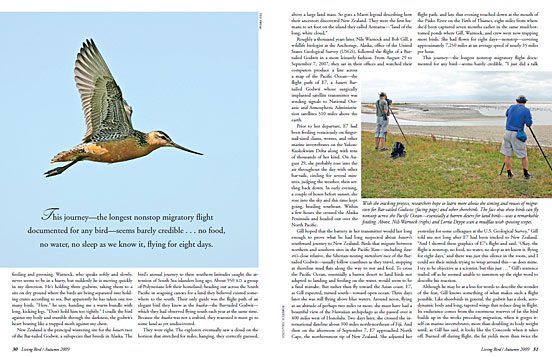
Prior to her departure, E7 had been feeding voraciously on fingernail-sized clams, worms, and other marine invertebrates on the Yukon-Kuskokwim Delta along with tens of thousands of her kind. On August 29, she probably rose into the air throughout the day with other bar-tails, circling for several minutes, judging the weather, then settling back down. In early evening, a couple of hours before sunset, she rose into the sky and this time kept going, heading southeast. Within a few hours she crossed the Alaska Peninsula and headed out over the North Pacific.
Gill hoped that the battery in her transmitter would last long enough to prove what he had long suspected about baueri’s southward journey to New Zealand. Birds that migrate between northern and southern sites in the Pacific Rim—includingbaueri’s close relative, the Siberian-nesting menzbieri race of the Bar-tailed Godwit—usually follow coastlines as they travel, stopping at shoreline mud flats along the way to rest and feed. To cross the Pacific Ocean, essentially a barren desert to land birds not adapted to landing and feeding on the water, would seem to be a fatal mistake. But rather than fly toward the Asian coast, E7, as Gill expected, turned south—toward open ocean. Three days later she was still flying above blue waters. Around noon, flying at an altitude of perhaps two miles or more, she must have had a beautiful view of the Hawaiian archipelago as she passed over it 400 miles west of Honolulu. Two days later, she crossed the international dateline about 300 miles north-northeast of Fiji. And then on the afternoon of September 7, E7 approached North Cape, the northernmost tip of New Zealand. She adjusted her flight path, and late that evening touched down at the mouth of the Piako River on the Firth of Thames, eight miles from where she’d been captured seven months earlier in the same mud-bottomed ponds where Gill, Warnock, and crew were now trapping more birds. She had flown for eight days—nonstop—covering approximately 7,250 miles at an average speed of nearly 35 miles per hour.
This journey—the longest nonstop migratory flight documented for any bird—seems barely credible. “I just did a talk yesterday for some colleagues at the U.S. Geological Survey,” Gill told me not long after E7 had been tracked to New Zealand. “And I showed these graphics of E7’s flight and said, ‘Okay, the flight is nonstop, no food, no water, no sleep as we know it, flying for eight days,’ and there was just this silence in the room, and I could see their minds trying to wrap around this—as does mine. I try to be objective as a scientist, but this just . . .” Gill’s sentence trailed off as he seemed unable to summon up the right word to describe his reaction.
Although he may be at a loss for words to describe the wonder of the feat, Gill knows something of what makes such a flight possible. Like shorebirds in general, the godwit has a sleek, aerodynamic body and long, tapered wings that reduce drag in flight. Its endurance comes from the enormous reserves of fat the bird builds up in the weeks preceding migration, when it gorges itself on marine invertebrates, more than doubling its body weight until, as Gill has said, it looks like the Concorde when it takes off. Burned off during flight, the fat yields more than twice the energy of comparable amounts of carbohydrates or protein. In addition, the godwit’s body undergoes a remarkable change: its intestines and gizzard, which the bird makes little use of during migration, shrink, allowing more space to store fat.
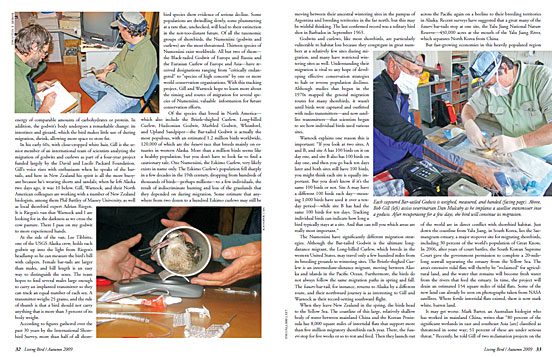
In his early 60s, with close-cropped white hair, Gill is the senior member of an international team of scientists analyzing the migration of godwits and curlews as part of a four-year project funded largely by the David and Lucile Packard Foundation. Gill’s voice rises with enthusiasm when he speaks of the bar-tails, and here in New Zealand his spirit is all the more buoyant because he’s wearing shorts and sandals; when he left Alaska two days ago, it was 10 below. Gill, Warnock, and their North American colleagues are working with a number of New Zealand biologists, among them Phil Battley of Massey University, as well as local shorebird expert Adrian Riegen. It is Riegen’s van that Warnock and I are looking for in the darkness as we cross the cow pasture. There I pass on my godwit to more experienced hands.
At the side of the van, Lee Tibbitts, one of the USGS Alaska crew, holds each godwit up into the light from Riegen’s headlamp so he can measure the bird’s bill with calipers. Female bar-tails are larger than males, and bill length is an easy way to distinguish the sexes. The team hopes to find several males large enough to carry an implanted transmitter so they can track an equal number of each sex. A transmitter weighs 25 grams, and the rule of thumb is that a bird should not carry anything that is more than 3 percent of its body weight.
According to figures gathered over the past 30 years by the International Shorebird Survey, more than half of all shorebird species show evidence of serious decline. Some populations are dwindling slowly, some plummeting at a rate that, unchecked, will lead to their extinction in the not-too-distant future. Of all the taxonomic groups of shorebirds, the Numeniini (godwits and curlews) are the most threatened. Thirteen species of Numeniini exist worldwide. All but two of them—the Black-tailed Godwit of Europe and Russia and the Eurasian Curlew of Europe and Asia—have received designations ranging from “critically endangered” to “species of high concern” by one or more world conservation organizations. With this tracking project, Gill and Warnock hope to learn more about the timing and routes of migration for several species of Numeniini, valuable information for future conservation efforts.
Of the species that breed in North America—which also include the Bristle-thighed Curlew, Long-billed Curlew, Hudsonian Godwit, Marbled Godwit, Whimbrel, and Upland Sandpiper—the Bar-tailed Godwit is actually the most populous, with an estimated 1.2 million birds worldwide, 120,000 of which are the baueri race that breeds mainly on estuaries in western Alaska. More than a million birds seems like a healthy population, but you don’t have to look far to find a cautionary tale. One Numeniini, the Eskimo Curlew, very likely exists in name only. The Eskimo Curlew’s population fell sharply in a few decades in the 19th century, dropping from hundreds of thousands of birds—perhaps millions—to a few individuals, the result of indiscriminate hunting and loss of the grasslands that they depended on during migration. Some estimate that anywhere from two dozen to a hundred Eskimo curlews may still be moving between their ancestral wintering sites in the pampas of Argentina and breeding territories in the far north, but this may be wishful thinking. The last confirmed record was a solitary bird shot in Barbados in September 1963.
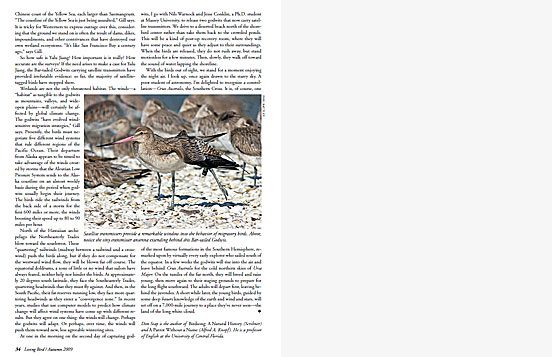
Godwits and curlews, like most shorebirds, are particularly vulnerable to habitat loss because they congregate in great numbers at a relatively few sites during migration, and many have restricted wintering sites as well. Understanding their migration is vital to any hope of developing effective conservation strategies to halt or reverse population declines. Although studies that began in the 1970s mapped the general migration routes for many shorebirds, it wasn’t until birds were captured and outfitted with radio transmitters—and now satellite transmitters—that scientists began to see how individual birds used various sites.
Warnock explains one reason this is important: “If you look at two sites, A and B, and site A has 100 birds on it on day one, and site B also has 100 birds on day one, and then you go back ten days later and both sites still have 100 birds, you might think each site is equally important. But you don’t know if it’s the same 100 birds or not. Site A may have a different 100 birds each day—meaning 1,000 birds have used it over a ten-day period—while site B has had the same 100 birds for ten days. Tracking individual birds can indicate how long a bird typically stays at a site. And that can tell you which areas are really most important.”
The Numeniini have significantly different migration strategies. Although the Bar-tailed Godwit is the ultimate long-distance migrant, the Long-billed Curlew, which breeds in the western United States, may travel only a few hundred miles from its breeding grounds to wintering sites. The Bristle-thighed Curlew is an intermediate-distance migrant, moving between Alaska and islands in the Pacific Ocean. Furthermore, the birds do not always follow the same migration paths in spring and fall. The baueri bar-tail, for instance, returns to Alaska by a different route, and their northward journey is as interesting to Gill and Warnock as their record-setting southward flight.
When they leave New Zealand in the spring, the birds head to the Yellow Sea. The coastline of this large, relatively shallow body of water between mainland China and the Korean Peninsula has 8,000 square miles of intertidal flats that support more than five million migratory shorebirds each year. There, the baueristop for five weeks or so to rest and feed. Then they launch out across the Pacific again on a beeline to their breeding territories in Alaska. Recent surveys have suggested that a great many of the baueri bar-tails stop at one site, the Yalu Jiang National Nature Reserve—450,000 acres at the mouth of the Yalu Jiang River, which separates North Korea from China.
But fast-growing economies in this heavily populated region of the world are in direct conflict with shorebird habitat. Just down the coastline from Yalu Jiang, in South Korea, lies the Saemangeum estuary, a major stopover site for migrating shorebirds, including 30 percent of the world’s population of Great Knots. In 2006, after years of court battles, the South Korean Supreme Court gave the government permission to complete a 20-mile-long seawall separating the estuary from the Yellow Sea. The area’s extensive tidal flats will thereby be “reclaimed” for agricultural land, and the water that remains will become fresh water from the rivers that feed the estuary. In time, the project will drain an estimated 154 square miles of tidal flats. Some of the new land can already be seen on photographs taken from NASA satellites. Where fertile intertidal flats existed, there is now stark white, barren land.
It may get worse. Mark Barter, an Australian biologist who has worked in mainland China, writes that “80 percent of the significant wetlands in east and southeast Asia [are] classified as threatened in some way; 51 percent of these are under serious threat.” Recently, he told Gill of two reclamation projects on the Chinese coast of the Yellow Sea, each larger than Saemangeum. “The coastline of the Yellow Sea is just being assaulted,” Gill says. It is tricky for Westerners to express outrage over this, considering that the ground we stand on is often the result of dams, dikes, impoundments, and other contrivances that have destroyed our own wetland ecosystems. “It’s like San Francisco Bay a century ago,” says Gill.
So how safe is Yalu Jiang? How important is it really? How accurate are the surveys? If the need arises to make a case for Yalu Jiang, the Bar-tailed Godwits carrying satellite transmitters have provided irrefutable evidence: so far, the majority of satellite-tagged birds have stopped there.
Wetlands are not the only threatened habitat. The winds—a “habitat” as tangible to the godwits as mountains, valleys, and wide-open plains—will certainly be affected by global climate change. The godwits “have evolved wind-sensitive migration strategies,” Gill says. Presently, the birds must negotiate five different wind systems that rule different regions of the Pacific Ocean. Their departure from Alaska appears to be timed to take advantage of the winds created by storms that the Aleutian Low Pressure System sends to the Alaska coastline on an almost weekly basis during the period when godwits usually begin their journey. The birds ride the tailwinds from the back side of a storm for the first 600 miles or more, the winds boosting their speed up to 80 to 90 miles per hour.

Bar-tailed Godwits of the baueri race migrate from breeding grounds in Alaska all the way to New Zealand and back each year. 
Researchers Lorna Deppe and Nils Warnock scan a mudflat for godwits. 
Biologists set up a mist net to catch godwits just before their northward migration at New Zealand's Miranda Shorebird Centre. 
Captured godwits are weighed, measured, and banded, then released for scientists to look for at the other end of their migration. 
A godwit fits snugly inside a makeshift weighing device. Next, bands and leg tags (on the table) will be attached. 
Veterinarian Dan Mulcahy implants a satellite transmitter in a few of the godwits. The bird gets to rest up for a few days and then starts northward, allowing the researchers to follow it to Alaska. 
Look closely to see the leg tag (just below outstretched wing, reading E9). Trailing behind the bird is a slim wire—that's the antenna of the satellite transmitter. 
Satellite transmitters provide a remarkable window into the behavior and travel patterns of migratory birds.
North of the Hawaiian archipelago the Northeasterly Trades blow toward the southwest. These “quartering” tailwinds (midway between a tailwind and a crosswind) push the birds along, but if they do not compensate for the westward wind flow, they will be blown far off course. The equatorial doldrums, a zone of little or no wind that sailors have always feared, neither help nor hinder the birds. At approximately 20 degrees south latitude, they face the Southeasterly Trades, quartering headwinds that they must fly against. And then, in the South Pacific, their fat reserves running low, they face more quartering headwinds as they enter a “convergence zone.” In recent years, studies that use computer models to predict how climate change will affect wind systems have come up with different results. But they agree on one thing: the winds will change. Perhaps the godwits will adapt. Or perhaps, over time, the winds will push them toward new, less agreeable wintering sites.
At one in the morning on the second day of capturing godwits, I go with Nils Warnock and Jesse Conklin, a Ph.D. student at Massey University, to release two godwits that now carry satellite transmitters. We drive to a deserted beach north of the shorebird center rather than take them back to the crowded ponds. This will be a kind of post-op recovery room, where they will have some peace and quiet as they adjust to their surroundings. When the birds are released, they do not rush away, but stand motionless for a few minutes. Then, slowly, they walk off toward the sound of water lapping the shoreline.
With the birds out of sight, we stand for a moment enjoying the night air. I look up, once again drawn to the starry sky. A poor student of astronomy, I’m delighted to recognize a constellation—Crux Australis, the Southern Cross. It is, of course, one of the most famous formations in the Southern Hemisphere, remarked upon by virtually every early explorer who sailed south of the equator. In a few weeks the godwits will rise into the air and leave behind Crux Australis for the cold northern skies of Ursa Major. On the tundra of the far north, they will breed and raise young, then move again to their staging grounds to prepare for the long flight southward. The adults will depart first, leaving behind the juveniles. A short while later, the young birds, guided by some deep baueri knowledge of the earth and wind and stars, will set off on a 7,000-mile journey to a place they’ve never seen—the land of the long white cloud.
Don Stap is the author of Birdsong: A Natural History (Scribner) and A Parrot Without a Name (Alfred A. Knopf). He is a professor of English at the University of Central Florida.

All About Birds
is a free resource
Available for everyone,
funded by donors like you
American Kestrel by Blair Dudeck / Macaulay Library
